

'Gandhi In The Gallery': a visual journey of artworks inspired by Mahatma Gandhi- by Deepa Alexander Sumathi Ramaswamy's book 'Gandhi In The Gallery' is a stunning visual journey of 130 artists and their artworks inspired by the Father of the Nation.
Gandhi was one of the most photographed men on the planet in his time — a symbol of pacifism, an inspiration to leaders such as Martin Luther King and Nelson Mandela, a celebrated father-figure to his countrymen. As he continues to be edified through art and sculpture, his body, ideas, and politics continue to inspire thousands of artists in India and the world. With the Mahatma as their muse, these artists have peppered the country's streets, universities, Government offices, public places, railway stations, galleries and beyond with their representation of him. Sumathi Ramaswamy, James B Duke Professor of History and International Comparative Studies Chair at Duke University, North Carolina, and president, American Institute of Indian Studies, gathers these forms — photographs, artworks and sculptures of Gandhi — in Gandhi In The Gallery - The Art of Disobedience (published by Roli Books). Sumathi was born in Chennai, a city that continues to be the centre of her research. For the book, she met artists from all over India and consulted archives across India, as well as at the British Library, London. In an email interview, Sumathi discusses how the book came to be. Edited excerpts: How does the book help the reader 'see' the Mahatma when he is visible everywhere?One of the epigraphs of the book by French philosopher Jean-Francois Lyotard alerts us to how art has the capacity to bring the submerged to the fore, and trigger new thought and discussion. By assembling and centring on works of art on Gandhi, I hope to have asked new questions about the Mahatma, and make us see him in a new light. How did the idea for the book originate?This is the first monograph that charts historically the investment by artists of India, from his own time into the present in the figure of Gandhi — the most painted, drawn or sculpted man amongst India's political leaders. In the vast scholarship on Gandhi, virtually no attention has been paid — other than in a few essays — to this investment. I think it is important because the artist of India has emerged as Gandhi's “conscience keeper”. At a time when the Mahatma has been reduced to a platitude, artists are continuing to re-interpret him for our times, and finding new meanings in his message. To some extent, the 150th anniversary of Gandhi's birth was an important landmark for me to address — because so many artists also felt compelled to produce new work, but also older works were once again brought back to visibility. How did you decide which works you would feature in the book?I neither meant to provide a comprehensive analysis of every artist who has been drawn to Gandhi, nor discuss every work that has ever been produced on him: that would be an encyclopaedic task. I focussed on his body: its appearance as bare and spare; its mobility; and its death. From the perspective of artworks, I chose those that spoke to the above conceptual themes around which each of the three core chapters is organised. Another important theme is the manner in which the historical photograph of Gandhi is repurposed, so I also chose works of art that drew upon it. As a historian of the image, I believe words and the figure have an intriguing relationship: I have attempted to open up this aspect, what can be stated about him but not shown, and conversely, what can be shown about him but not verbalised. How long has it been in the writing?I began engaging with Gandhi visually when I wrote The Goddess and the Nation (2010), in which I explored lithographs that feature him as Mother India's devoted son. Later, Delhi-based curator Gayatri Sinha approached me to do a piece on him and that led me to write The Mahatma as Muse: An Image Essay on Gandhi in Popular Indian Visual Imagination. In both projects, I focussed on popular, mass-produced art, rather than singular high-end works, which is the dominant focus of Gandhi In The Gallery. The book took a little over two years — tracking down artworks, their copyright holders and seeking permissions for reproduction. Some of the biggest public repositories of artworks on Gandhi are memorials like the National Gandhi Museum in New Delhi, and Mani Bhavan Gandhi Sangrahalaya in Mumbai, to which artists both Indian and foreign have donated works. Many of these remain uncatalogued, and in the reserve collection, and need to be brought to light. The artist most represented in my book is Mumbai-based Atul Dodiya, who has produced such a vast number of complex works on Gandhi — each of which attempt a new interpretation. The cover image by Tallur LN, was chosen for its sheer beauty when I saw it on display in the US last year. It so strikingly addresses the three principal themes I have focussed on — the art of baring, of walking, and of dying. Which art form do you think defines the Mahatama's character well?Gandhi has been featured in every possible “form,” ranging from children's doodles to digital works, although paintings (in watercolour and oil) and sculptures dominate. Gandhi was given to minimalism, so the artworks that favour a minimalist aesthetic — the pen and ink drawings of Madras artist KM Adimoolam, some of which have been included in the book, come to mind. Courtesy: The Hindu, dt. 03.12.2020 |